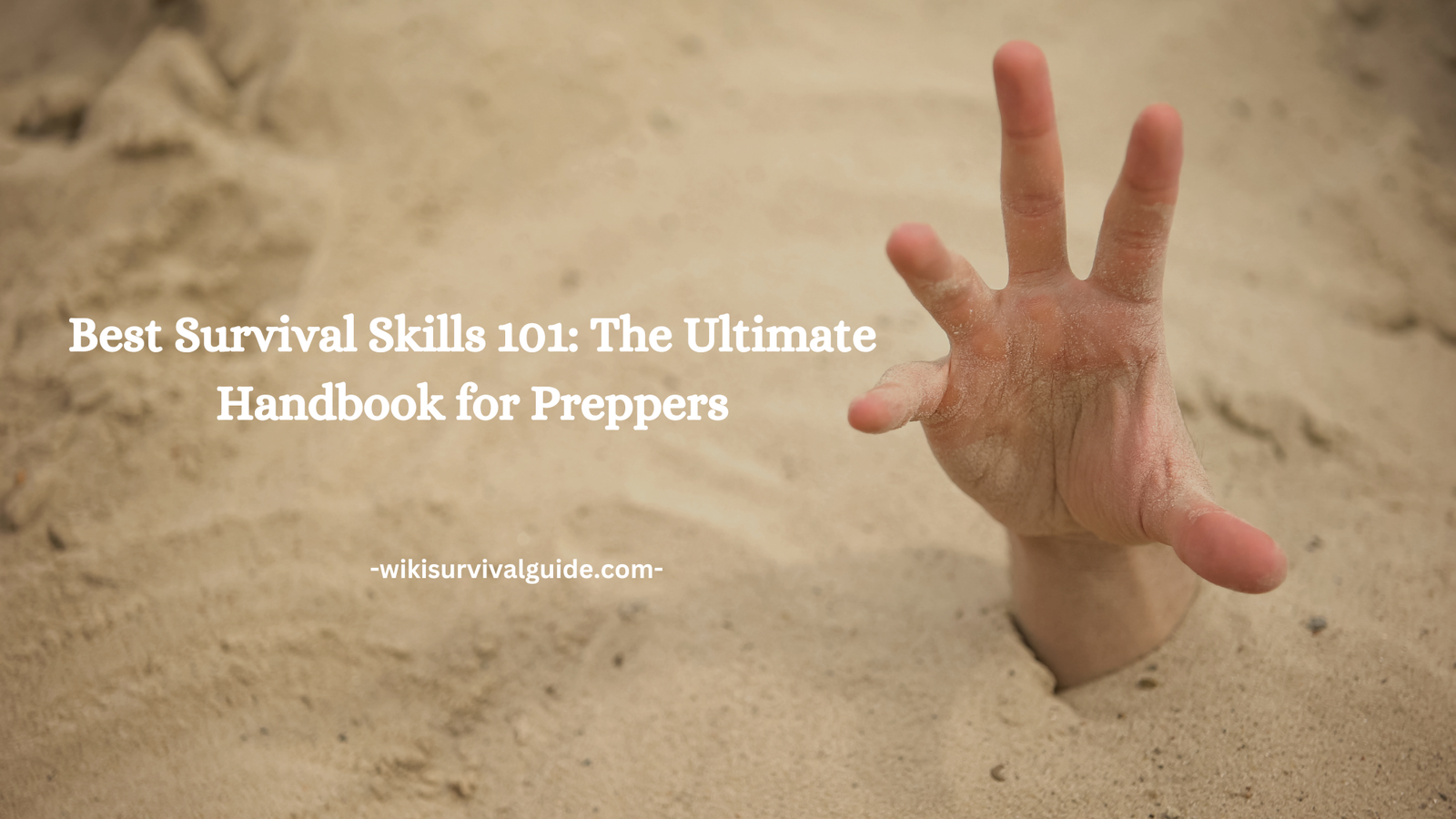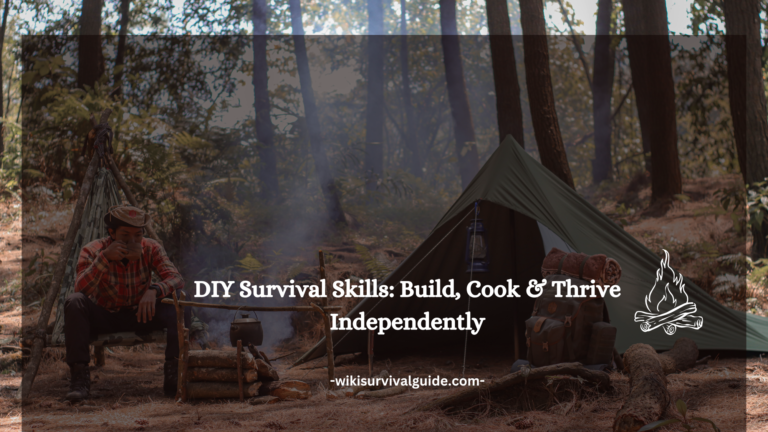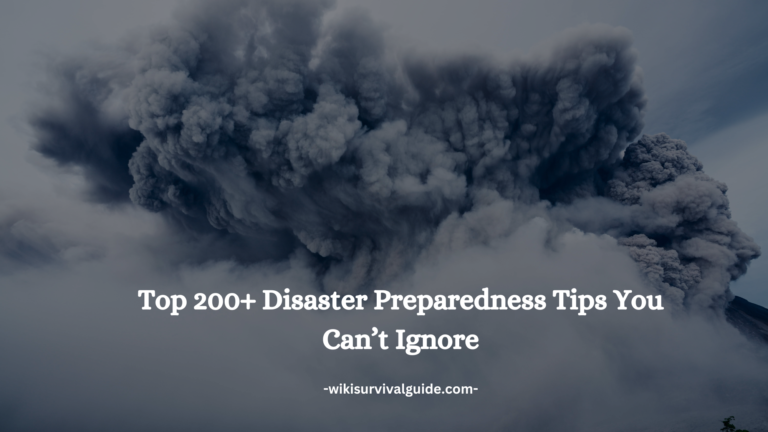Survival isn’t just about braving the wild with nothing but a knife and some grit. Whether you’re caught in a natural disaster, lost in the woods, or facing an unexpected emergency, knowing essential survival techniques can mean the difference between life and death.
This Best Survival Skills 101: The Ultimate Handbook for Preppers will walk you through everything you need to know to stay safe, from wilderness survival tips to emergency preparedness. If you’ve ever wondered how to start a fire without matches or purify water in a crisis, keep reading—because being prepared starts right here.

Understanding the Basics of Survival
Survival isn’t just about having the right gear—it’s about having the right mindset and knowledge. When faced with an emergency, whether in the wilderness or during a disaster, understanding fundamental survival principles can mean the difference between life and death.
The Rule of Threes
A crucial survival concept is the Rule of Threes:
- You can survive three minutes without air (or in icy water).
- You can survive three hours without shelter in extreme weather.
- You can survive three days without water before dehydration sets in.
- You can survive three weeks without food, though starvation weakens the body.
This rule helps you prioritize your actions in an emergency. If you’re stranded in freezing temperatures, finding shelter takes precedence over finding food.
Survival Mindset and Adaptability
Survival is as much a mental challenge as it is a physical one. Fear and panic can lead to poor decision-making. Staying calm and assessing the situation logically increases your chances of survival. Preppers and survivalists often use the S.T.O.P. method:
- Stop – Take a deep breath and don’t panic.
- Think – Assess your situation and surroundings.
- Observe – Look for resources, dangers, and escape routes.
- Plan – Make a clear strategy before acting.
Situational Awareness
Being aware of your surroundings at all times is key. In urban environments, knowing exits, potential dangers, and safe zones can save lives. In the wilderness, recognizing animal tracks, weather changes, and available resources is essential.
Mastering these survival basics builds confidence, allowing you to make smarter decisions when disaster strikes.
Essential Survival Techniques for Any Situation
Survival isn’t a one-size-fits-all skill set. Whether stranded in the wilderness, facing a power outage, or dealing with civil unrest, certain techniques apply across all scenarios. These include fire-making, water purification, shelter building, food sourcing, and signaling for help.
Prioritizing Your Actions
When faced with an emergency, always assess your immediate needs. Using the Rule of Threes, determine what is most urgent: staying warm, finding water, or seeking shelter.
- Fire-Making – Provides warmth, protection, and the ability to cook food.
- Water Purification – Prevents dehydration and disease.
- Shelter Construction – Protects against extreme weather.
- Food Sourcing – Hunting, fishing, or foraging when necessary.
- Navigation and Signaling – Finding help or returning to safety.
Improvisation: Using What You Have
A true survivalist knows how to adapt. Everyday objects can be repurposed:
- A shoelace can be turned into a bowstring for fire-starting.
- A car’s rearview mirror can be used as a signal reflector.
- Duct tape can fix broken gear or even be used for first aid.
Using creativity to solve problems is a core part of survival training.
Practicing Survival Techniques Before You Need Them
Waiting for a crisis to learn survival skills is a dangerous mistake. Regular practice is essential:
- Test your ability to start a fire using different methods.
- Practice purifying water using various techniques.
- Build a temporary shelter in your backyard.
- Learn edible plants and basic foraging skills.
Survival knowledge is useless if you don’t practice it. The more familiar you are with these techniques, the more second nature they become in an actual emergency.
Fire-Making Skills: Different Methods to Start a Fire
Fire is one of the most essential survival tools. It provides warmth, light, protection from predators, and the ability to cook food and boil water. However, starting a fire in an emergency can be challenging, especially without matches or a lighter. Understanding multiple fire-starting techniques ensures you’re never left in the cold.
Basic Fire-Starting Methods
1. Ferro Rod and Striker
A ferrocerium rod (ferro rod) produces hot sparks when scraped with a metal striker. It works in all weather conditions and is a must-have in any survival kit.
How to use it:
- Gather dry tinder such as dry leaves, cotton balls, or wood shavings.
- Hold the rod close to the tinder and scrape it with the striker.
- Aim sparks onto the tinder until it ignites.
2. Flint and Steel
This is an ancient but effective method. Striking flint against steel generates sparks that ignite char cloth or dry tinder.
Best for: Preppers who want a reliable, long-lasting fire-starting method.
3. Fire from Batteries and Steel Wool
If you have a 9V battery and steel wool, you can start a fire almost instantly. The fine steel strands short-circuit the battery, creating a spark.
Steps:
- Stretch out the steel wool to increase surface area.
- Rub the battery terminals against the wool.
- Once the wool ignites, transfer it to dry tinder and blow gently to grow the flame.
4. The Bow Drill Method
This is a primitive but effective method that uses friction to generate heat. It requires:
- A bow (curved stick with a cord)
- A spindle (a straight stick)
- A fireboard (flat wood with a small divot)
By moving the bow back and forth, the spindle creates friction against the fireboard, producing embers that can be transferred to tinder.
Fire Safety and Precautions
Fire can be dangerous if not handled properly. Always:
- Clear a fire-safe zone by removing flammable materials nearby.
- Keep water or sand nearby to extinguish the fire if necessary.
- Never leave a fire unattended.
- Fully extinguish fires before leaving the area.
Mastering these fire-making skills ensures you’re prepared for any survival scenario. Whether you’re camping, lost in the wilderness, or facing a power outage, knowing multiple ways to create fire can be the difference between life and death.
Finding and Purifying Water in the Wild
Water is the most crucial element for survival. While humans can survive weeks without food, dehydration can be fatal in just a few days. Knowing where to find water and how to purify it is essential for survival in the wild.
Where to Find Water in the Wild
1. Natural Water Sources
- Rivers, Streams, and Lakes – Flowing water is usually safer than stagnant water.
- Rainwater Collection – Use a tarp, leaves, or even your clothing to collect rainwater.
- Morning Dew – Wipe dew off grass with a cloth and wring it into a container.
2. Underground Water Sources
- Digging for Water – If the ground is damp, digging a few inches may reveal hidden water.
- Tree Roots and Plants – Some trees, like cacti and vines, store drinkable water.
Purifying Water for Safe Drinking
Even if water looks clean, it can contain harmful bacteria or parasites. Purification is essential.
1. Boiling Water
Boiling is the most effective way to kill bacteria and viruses. Bring water to a rolling boil for at least one minute (or three minutes at higher altitudes).
2. Using Water Purification Tablets
These are lightweight and easy to carry. Drop one tablet into a liter of water and wait 30 minutes before drinking.
3. Portable Water Filters
Survival filters, like LifeStraw or Sawyer filters, remove most bacteria and protozoa, making them an excellent emergency option.
4. Solar Disinfection (SODIS)
Fill a clear plastic bottle with water and leave it in direct sunlight for six hours. UV rays kill many harmful organisms.
Mastering these techniques ensures you won’t go thirsty in a survival situation.
Building a Shelter for Protection
A shelter protects you from harsh weather, wildlife, and exhaustion. Exposure to extreme temperatures can lead to hypothermia or heatstroke, making shelter-building a top priority.
Types of Survival Shelters
1. Lean-To Shelter
This simple and quick shelter is built by propping a long branch against a sturdy tree or rock and layering branches, leaves, or tarps for coverage. Ideal for short-term survival.
2. Debris Hut
A debris hut provides excellent insulation. Pile leaves, grass, and sticks over a frame made of branches. The thicker the debris layer, the warmer it stays inside.
3. Tarp or Poncho Shelter
A tarp or poncho tied between two trees creates a waterproof barrier. If you have paracord, this is one of the fastest and most efficient shelter options.
4. Snow Cave
In snowy conditions, digging a small cave into a snowbank traps body heat and protects against wind chill.
Key Shelter Considerations
- Location – Avoid low areas where cold air settles and places near rivers that could flood.
- Wind Protection – Position the entrance away from prevailing winds.
- Insulation – Use leaves, grass, or clothing to create a barrier between your body and the cold ground.
A well-built shelter can mean the difference between life and death in extreme conditions.
Wilderness Survival Tips for Different Environments
Different terrains present unique survival challenges. Whether you’re in the forest, mountains, or desert, understanding the landscape helps you adapt and survive.
General Wilderness Survival Tips
- Stay calm and assess your situation before making a move.
- Use the Rule of Threes to prioritize needs (shelter, water, fire, food).
- Always carry a basic survival kit with essentials like a knife, fire starter, and compass.
Weather-Specific Adaptations
- Cold Weather – Layer clothing, avoid sweating, and insulate your shelter.
- Hot Weather – Seek shade, stay hydrated, and cover your skin from the sun.
- Rainy Conditions – Build waterproof shelter, collect rainwater, and keep fire-starting materials dry.
Knowing how to adapt to each environment ensures you’re ready for any situation.
Surviving in Forests and Mountains
Forests and mountains provide plenty of resources but also unique dangers. From navigating dense woods to avoiding predators, surviving in these environments requires skill and preparation.
Finding Food and Water
- Look for Edible Plants – Learn to identify wild berries, nuts, and roots.
- Fish and Trap Game – Small game like rabbits and birds can be trapped using snares.
- Collect Water from Streams – Moving water is safer than stagnant ponds.
Navigation in Dense Forests
- Use the Sun – The sun rises in the east and sets in the west, helping with direction.
- Follow Animal Trails – They often lead to water sources.
- Mark Your Path – Use tree carvings or stacked rocks to avoid getting lost.
Avoiding Forest Hazards
- Beware of Poisonous Plants – Learn to identify and avoid toxic plants like poison ivy.
- Watch for Predators – Stay alert for bears, wolves, or mountain lions. Keep food stored away from sleeping areas.
- Prepare for Sudden Weather Changes – Forests and mountains can experience rapid temperature drops.
By using the forest’s natural resources and staying vigilant, you can increase your chances of survival.
Desert Survival Strategies
Deserts are among the most challenging survival environments due to extreme heat, scarce water, and lack of shelter. However, with the right strategies, you can survive even in the harshest conditions.
Water Conservation and Finding Sources
- Travel at dawn and dusk to avoid excessive sweating and dehydration.
- Look for Signs of Water – Animal tracks, green vegetation, and bird activity can indicate water nearby.
- Dig for Water – Dry riverbeds may have moisture underground. Dig a hole and wait for water to seep in.
Heat Protection and Shelter
- Stay in the shade during peak heat hours (10 AM – 4 PM).
- Wear loose, light-colored clothing to reflect sunlight.
- Use Natural Shelters – Rock formations, caves, or even digging a trench can provide relief from the sun.
Finding Food in the Desert
- Cacti and Succulents – Some provide hydration, but ensure they are non-toxic before consuming.
- Insects and Small Animals – Scorpions, lizards, and insects are protein sources. Cook them to kill parasites.
Avoiding Desert Hazards
- Watch for Venomous Creatures – Snakes, scorpions, and spiders hide in shaded areas. Check boots and sleeping spots before use.
- Prevent Sunburn and Heatstroke – Cover your skin, wear a hat, and use makeshift sun protection.
- Plan Your Route Carefully – Deserts can be disorienting. Mark your path to avoid getting lost.
Desert survival is all about conserving energy and water while protecting yourself from the elements. With proper preparation, even this extreme environment can be managed.
Urban Survival Skills
Survival isn’t just about wilderness survival—urban environments come with their own dangers, especially during disasters, civil unrest, or economic collapse. Knowing how to navigate an urban survival scenario can make all the difference.
Key Urban Survival Challenges
- Crowds and Panic – Cities become dangerous during crises as people panic and supplies dwindle.
- Limited Resources – Food, water, and medical supplies disappear quickly.
- Security Risks – Looting and violence increase when law enforcement is overwhelmed.
Essential Urban Survival Skills
1. Situational Awareness
Being aware of your surroundings prevents you from walking into dangerous situations. Avoid large crowds, know emergency exits, and always have an escape plan.
2. Finding and Storing Water
Tap water may become undrinkable during disasters. Always store extra water at home and know how to purify contaminated sources using filtration or boiling.
3. Bartering and Negotiation
When cash becomes useless, goods and services become currency. Having tradeable items like food, medicine, and tools can be a lifesaver.
4. Stealth and Low Profile (Gray Man Strategy)
Blending in helps you avoid becoming a target. Avoid flashy clothing, loud behavior, or drawing attention to yourself, especially if resources are scarce.
5. Alternative Transportation
In a crisis, roads may be blocked or dangerous. Bicycles, scooters, or even walking may be your best option for getting around.
Mastering urban survival skills ensures you can navigate disasters while staying safe and prepared.
Emergency Preparedness: What Every Prepper Needs
Being prepared before a disaster strikes is the key to survival. Preppers focus on food, water, shelter, security, and self-sufficiency to withstand emergencies.
The Basics of Emergency Preparedness
1. Stockpile Essentials
- Water – Store at least one gallon per person per day for drinking and sanitation.
- Non-Perishable Food – Canned goods, rice, beans, and freeze-dried meals.
- Medical Supplies – A well-stocked first aid kit, medications, and sanitation supplies.
2. Create a Family Emergency Plan
- Designate Meeting Points – Choose a safe place in case of separation.
- Plan Multiple Escape Routes – Know different ways to leave your city or home safely.
- Stay Informed – Use a battery-powered radio for news updates.
3. Home Defense and Security
- Reinforce doors and windows.
- Keep emergency lighting and self-defense tools.
- Have a security plan to protect your family from intruders.
4. Financial Preparedness
- Keep emergency cash on hand.
- Store important documents in waterproof containers.
- Invest in barterable goods like fuel, batteries, and hygiene products.
Preparedness isn’t paranoia—it’s the smart way to ensure survival when disaster strikes.
Creating a Survival Kit: Must-Have Items
A survival kit contains essential tools and supplies to keep you alive in an emergency. Whether for wilderness survival or urban disasters, having a bug-out bag (BOB) ready is crucial.
Survival Kit Essentials
1. Water and Hydration
- Water bottles and a collapsible water container
- Water purification tablets or a portable filter
2. Food and Cooking
- High-calorie energy bars and MREs (Meals Ready to Eat)
- A lightweight stove with fuel or fire-starting tools
3. Shelter and Warmth
- Compact tent or emergency bivvy bag
- Mylar blankets for heat retention
4. First Aid and Hygiene
- A fully stocked first aid kit
- Wet wipes, hand sanitizer, and a compact towel
5. Tools and Defense
- Multi-tool or survival knife
- Tactical flashlight and extra batteries
- Pepper spray or a self-defense weapon
A 72-hour survival kit can be a lifesaver during evacuations or unexpected emergencies.
Food Storage and Preservation Methods
Stockpiling food is essential for long-term survival. Knowing how to store, preserve, and rotate food ensures you never run out when disaster strikes.
Best Foods for Long-Term Storage
- Grains and Legumes – Rice, beans, lentils (last for decades when stored properly).
- Canned Goods – Vegetables, meats, and soups with long shelf lives.
- Freeze-Dried Foods – Lightweight and lasts up to 25 years.
Food Preservation Techniques
1. Dehydration
- Removes moisture, preventing mold and bacteria growth.
- Works well for fruits, vegetables, and meats (jerky).
2. Canning and Vacuum Sealing
- Canning preserves food in airtight containers.
- Vacuum-sealing extends shelf life by removing air exposure.
3. Root Cellaring
- Uses underground storage to keep produce fresh without electricity.
- Works well for potatoes, onions, carrots, and apples.
Proper food storage means your family won’t go hungry in a long-term crisis.
First Aid Skills and Medical Preparedness
In survival situations, access to medical care may be limited. Knowing basic first aid can prevent infections, treat injuries, and even save lives.
Essential First Aid Skills
- Stopping Bleeding – Use pressure and bandages to prevent excessive blood loss.
- CPR and Rescue Breathing – Helps revive someone who has stopped breathing.
- Treating Burns and Wounds – Clean wounds immediately and cover them with sterile dressings.
Survival Medical Supplies
- Antiseptics and Bandages – To prevent infection and aid healing.
- Pain Relievers and Antibiotics – Essential for managing pain and preventing infection.
- Splints and Tourniquets – Useful for fractures and severe bleeding.
Being medically prepared increases your survival odds in a crisis.
Self-Defense and Security in Survival Situations
In post-disaster scenarios, crime, looting, and violence often increase. Protecting yourself and your loved ones is critical.
Self-Defense Strategies
1. Home Security
- Reinforce doors and windows.
- Install motion-activated lighting.
- Keep a home defense weapon (if legally allowed).
2. Personal Protection
- Carry a knife, pepper spray, or a self-defense tool.
- Learn hand-to-hand combat techniques.
- Always stay aware of potential threats.
3. Community and Group Defense
- Form a survival group with trusted friends or neighbors.
- Have a communication plan in case of an attack.
Self-defense is about prevention first, but knowing how to fight back when necessary can save your life.
Navigation and Communication During Emergencies
When GPS and cell towers go down, knowing how to navigate and communicate is essential for survival.
Navigation Without Technology
- Using the Sun and Stars – The sun rises in the east and sets in the west.
- Map and Compass Reading – Learn topographic maps and compass use.
- Landmark Navigation – Use mountains, rivers, and trails as guides.
Communication When the Grid Fails
- Two-Way Radios – Walkie-talkies work within short distances.
- HAM Radios – Work even when traditional communication is down.
- Emergency Whistles and Signal Mirrors – Simple but effective for rescue situations.
Mastering off-grid navigation and communication ensures you stay connected and find your way to safety.
Conclusion
Survival isn’t just about roughing it in the wild—it’s about being prepared for anything life throws your way. By mastering these essential survival techniques, you can protect yourself and your loved ones in emergencies. Whether you’re an urban dweller or an outdoor enthusiast, the time to prepare is now.
FAQs
1. What are the top three survival skills everyone should learn?
Fire-starting, water purification, and basic first aid are the most critical survival skills.
2. How do I start prepping on a budget?
Start small with a basic survival kit, stockpile affordable food, and learn DIY survival skills instead of buying expensive gear.
3. What is the best way to find water in the wilderness?
Look for natural water sources like rivers and streams, collect rainwater, and use purification tablets or boiling to make it safe to drink.
4. How can I protect myself during an emergency?
Stay aware of your surroundings, have self-defense training, and secure your shelter or home against intruders.5. What should I include in a basic survival kit?
A knife, fire starter, water purification system, first aid kit, emergency food, and a means of communication like a radio.




1 Comment